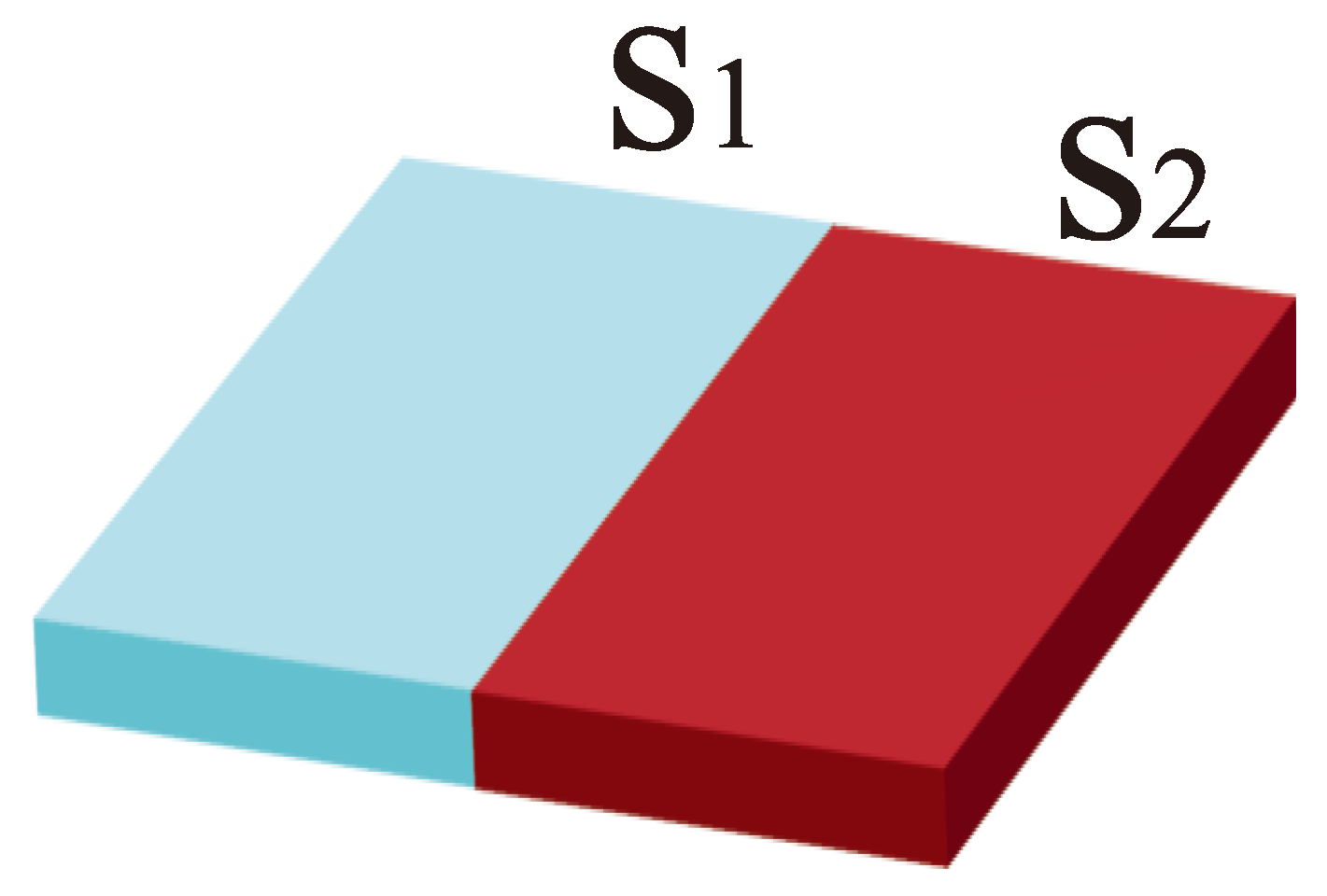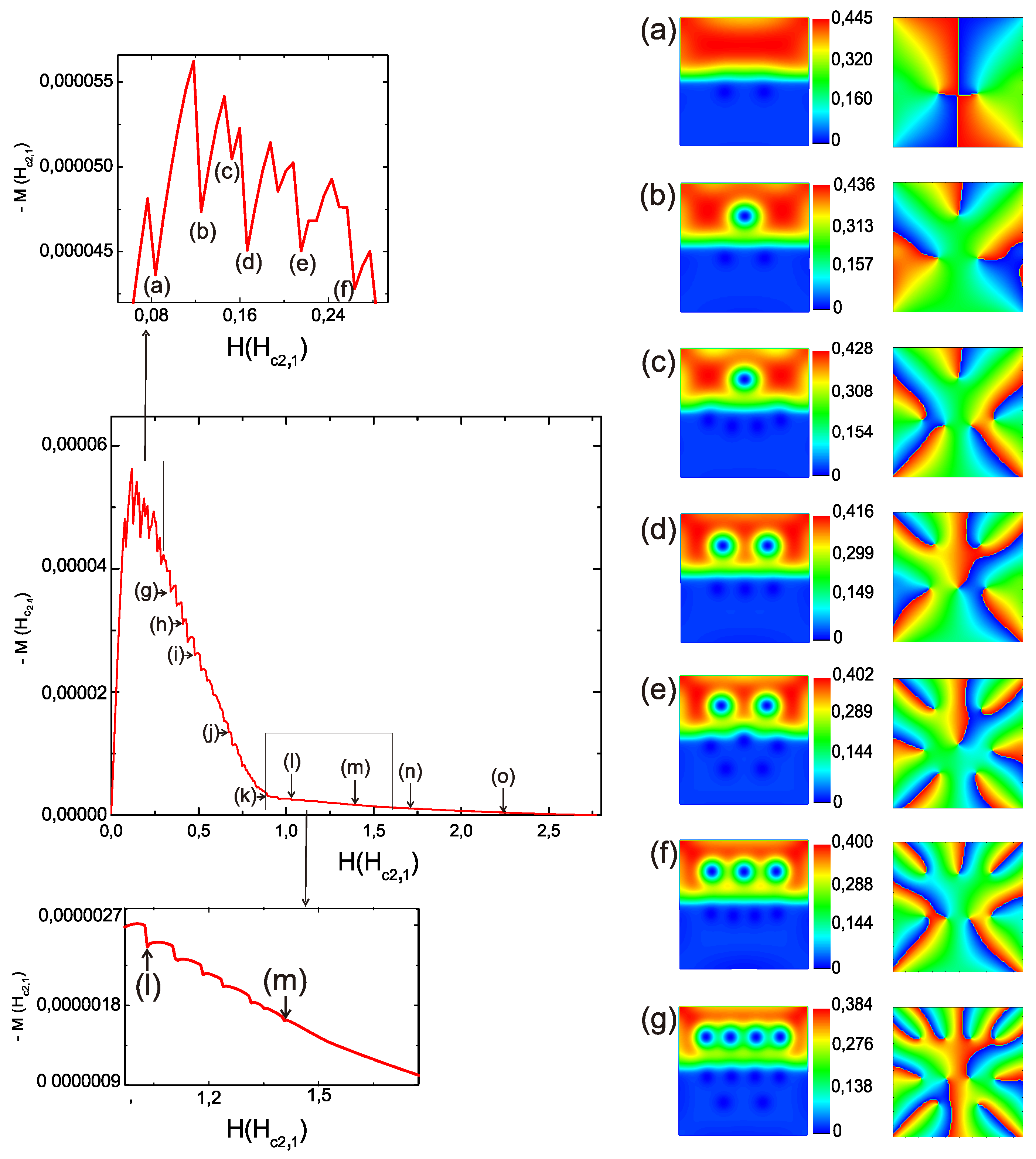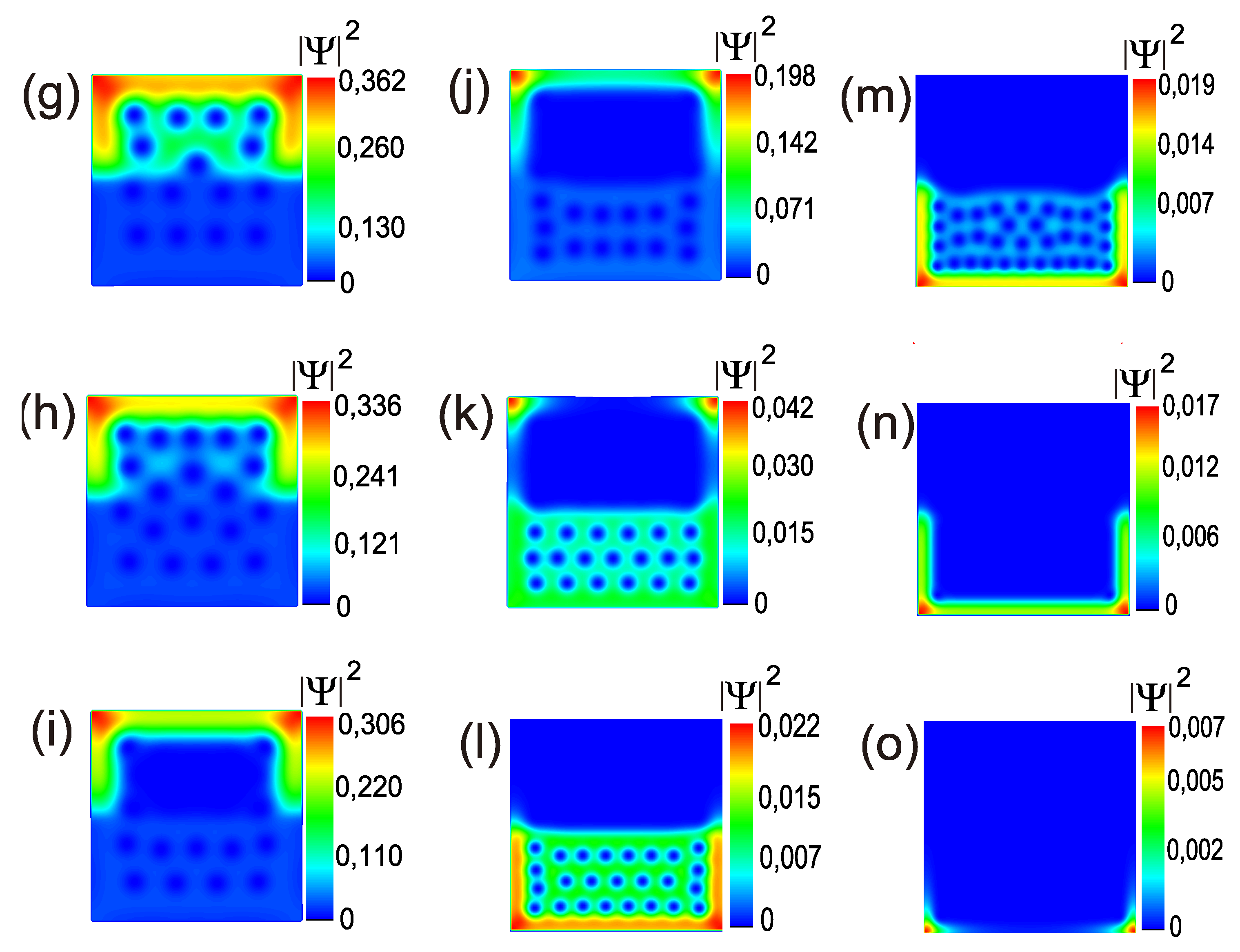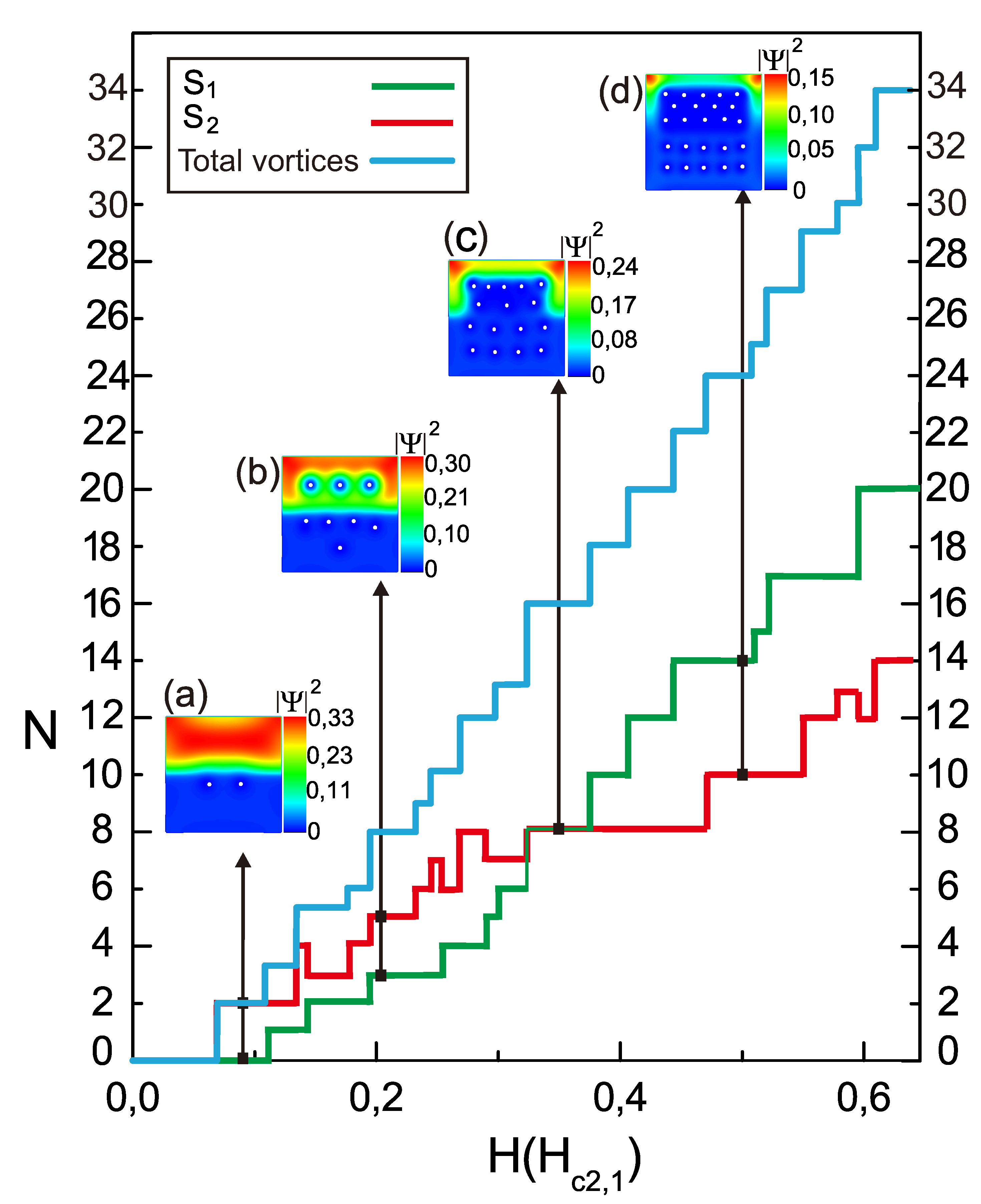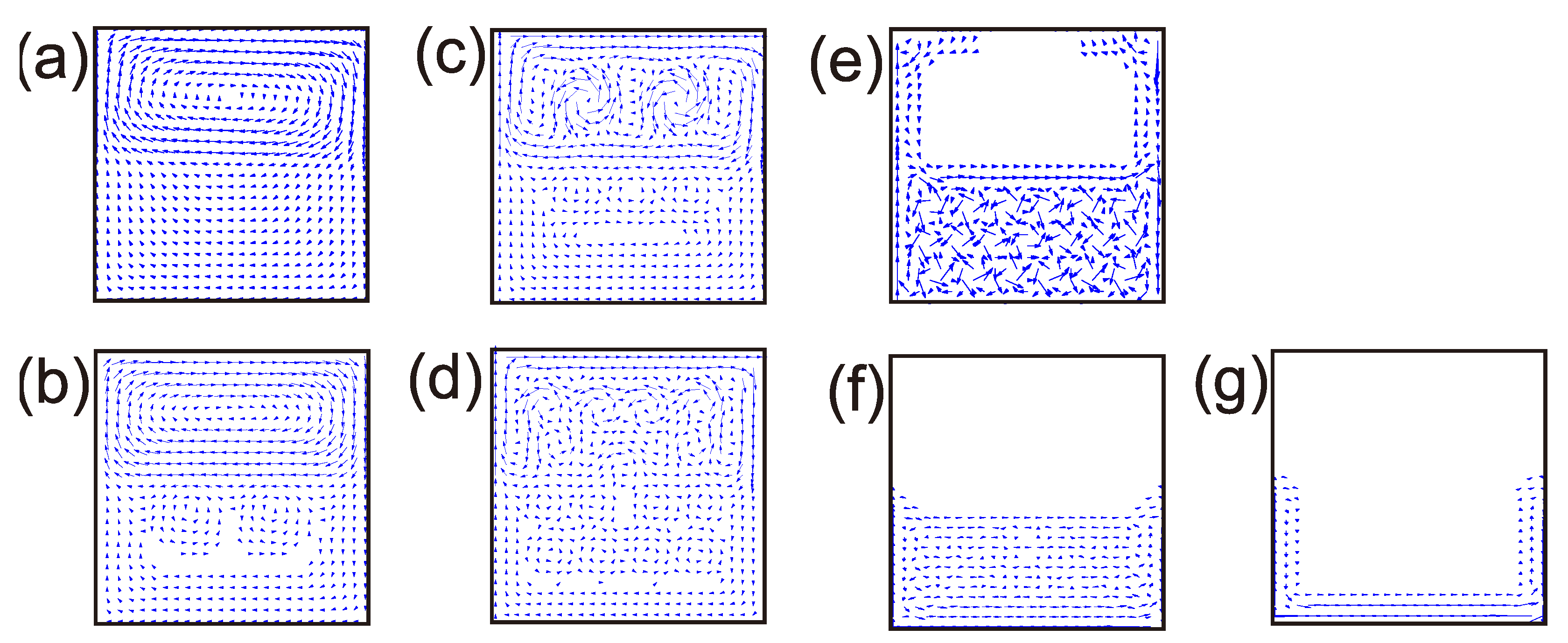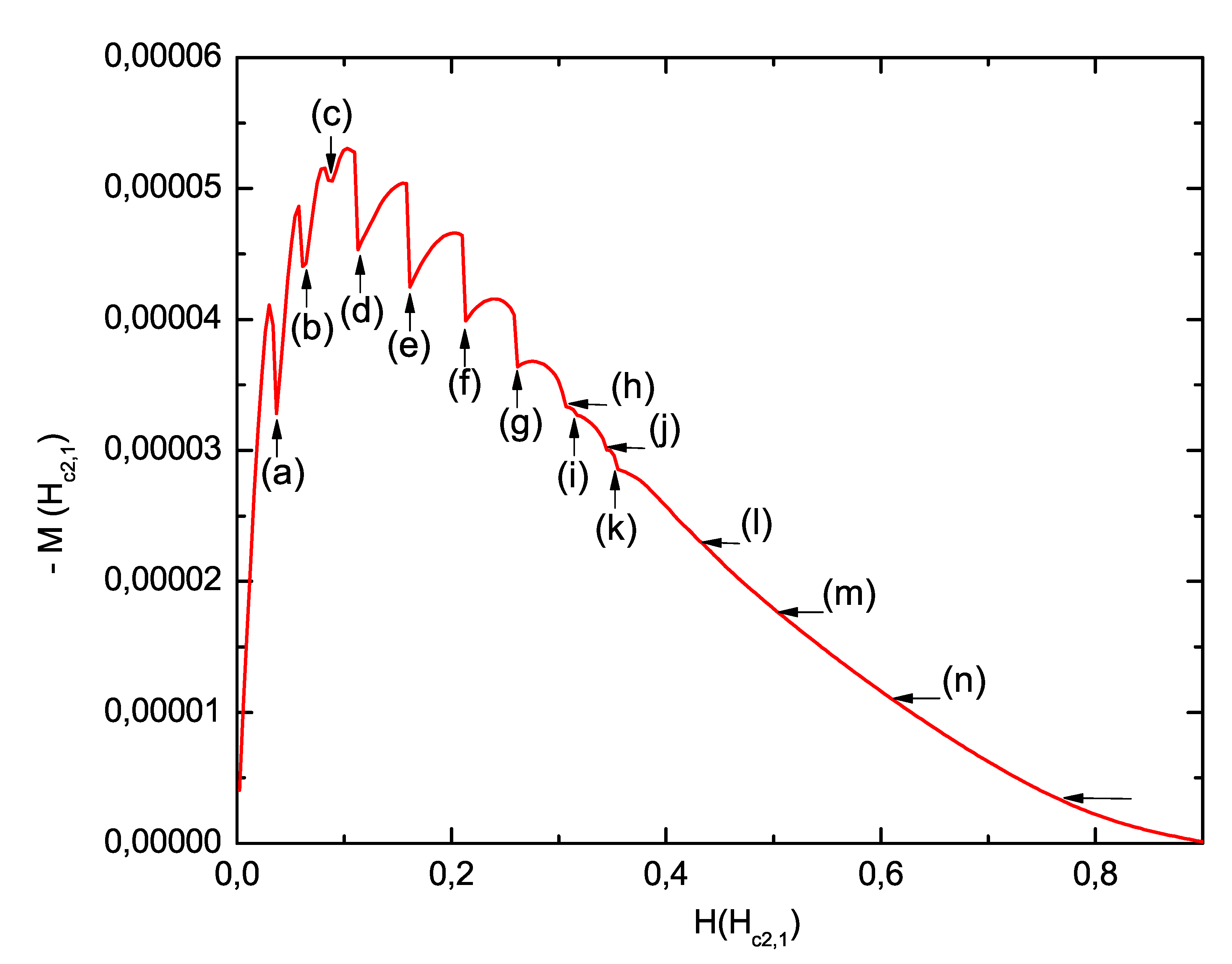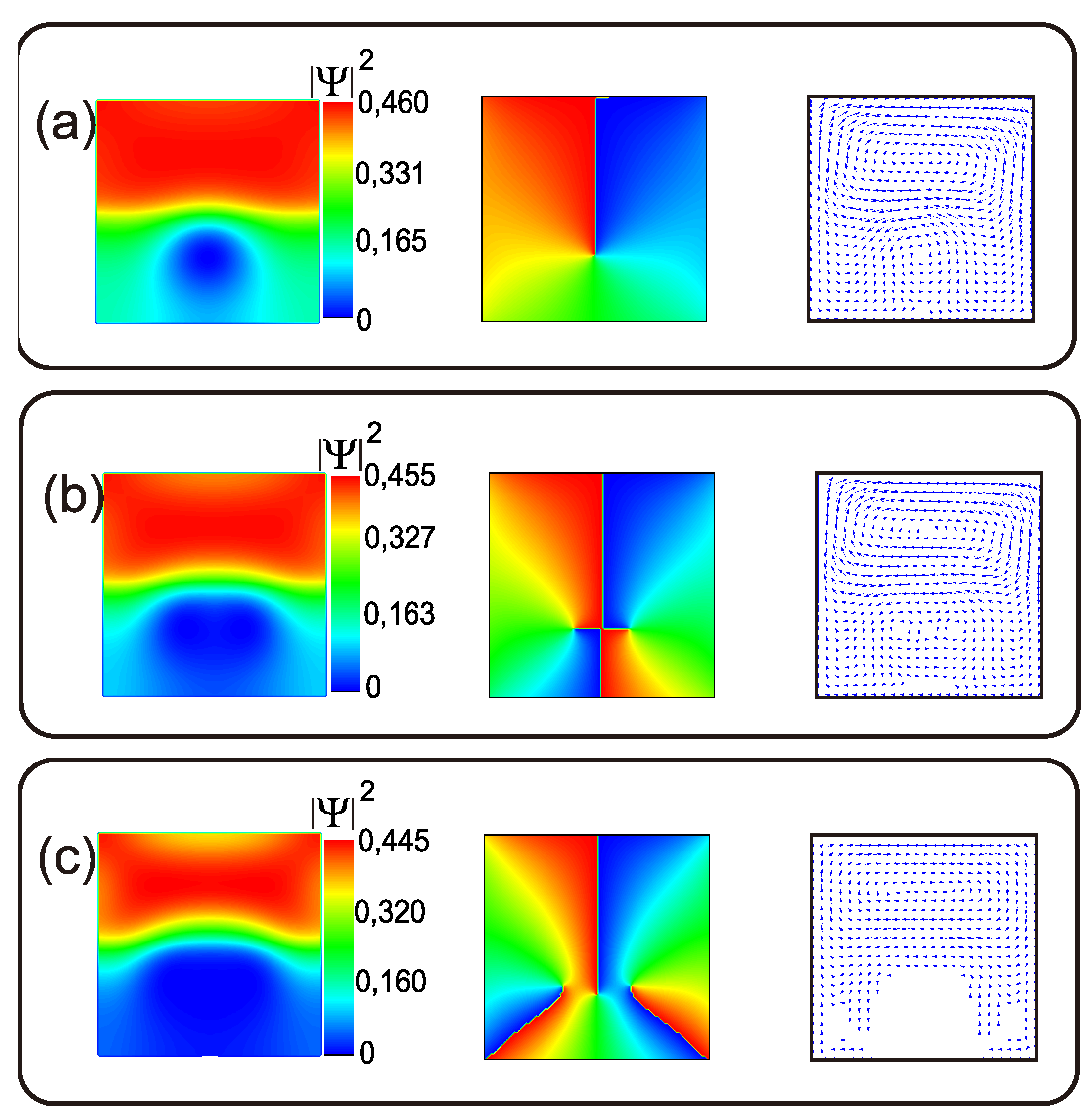0. Introduction
Usually, the interconnection of materials at the quantum level with superconducting condensates leads to a leakage of Cooper pairs through heterointerfaces, which is known as the proximity effect [
1]. This procedure has become a route to the design of superconducting electronics and the engineering of new quantum states, including the development of hybrid quantum devices, which have opened an important area in research based on advances in fabricating nanostructures with highly controllable accuracy, thus allowing their physical and electronic properties, as well as their power consumption, to be manipulated and tailored. Research on hybrid superconducting structures, which are made up of a superconductor and non-superconducting material, takes the proximity effect into account, as this explains the correlations of adjacent non-superconducting layers [
2,
3,
4,
5,
6,
7,
8]. The freedom in the design and fabrication of the heterostructures of emergent two-dimensional (2D) materials [
9,
10] has opened the possibility for research on the interactions of fundamental properties at the nanoscale. Such research results show that is possible to control the critical temperature, critical magnetic field, and energy gaps in selected regions as a result of the creation of tailored nanostructured superconductors with complex superconductor materials for applications in quantum technology. These developments have allowed new advances, including the superconducting proximity effect in epitaxial graphene induced by a graphene–superconductor interface [
11]. Numerical calculations have shown many effects that are usually observed in nanostructured superconductors, and these result in complex vortex patterns when barriers or defects are included [
12,
13,
14,
15]. Additionally, the inclusion of anisotropies in superconducting samples through variations in
in different layers of the sample leads to distinct vortex states and free-energy curves [
16,
17,
18], as well as new possibilities for non-conventional vortex structures [
19]. These kinds of systems exhibit a variety of new and interesting phenomena with no counterparts in conventional single-component superconductors [
20]. Exotic vortex structures can emerge in a two-component superconductor because of the different length scales
at which the Cooper-pair density varies in each component [
21]. Two-dimensional superconductivity has been investigated to find insights into a variety of quantum phenomena; the thermal evaporation and sputtering of metallic films allow the study of most of the basic properties of 2D superconductors [
21,
22]. The methods for fabrication, such as quantum phase transitions, open new discussions and opportunities for the study of thin-film superconductors with thicknesses from 0.3 nm to 10 nm [
23,
24].
Previously, fabrication techniques such as molecular beam epitaxy accompanied by surface or interface reconstruction processes and methods for the production of field-effect devices and mechanical exfoliation were introduced into the field of 2D superconductors [
25,
26,
27]; as a result, crystallinity has been greatly improved, even in atomically thick samples. The different phenomena associated with hybrid combinations with other superconductors have shown relevant effects, such as the magnetic field-driven quantum phase transition that takes place electrostatically in superconducting interfaces, among other effects [
28,
29]. In addition, combinations with low-dimensional semiconductors offer a versatile ground for novel device concepts, such as supercurrent transistors, sources of spin-entangled electrons, quantum computation, and nano-SQUIDS. When a superconductor is coupled with another superconductor, very interesting phenomena take place; both condensates interact with each other at the interface, and the supercurrent can be modulated in this region. In this context, the modulated domain–wall superconductivity offers the possibility of controlling the strength of superconductivity at will. The underlying physics behind such hybrid devices ultimately rely on the superconductors that are selected for coupling.
In the present contribution, we study the fundamental properties and vortex matter of hybrid superconducting samples made of two superconductors, in which each component is well known. The desired parameters of the components, as well as the geometry, type, and distribution of each superconductor, are chosen. In our work, we modified the G-L formalism in order to study hybrid superconducting samples; the interaction between the two densities of the superconductors and the order parameters that occurred in the interface between the soft and wall domains were modulated with high precision by using the fundamental parameters of each superconductor.
In
Sec. 1, we show the derived G-L equations and the ratios of intrinsic parameters of superconductivity, and this procedure is used in the calculations. In
Sec. 2, we analyze the results obtained for hybrid samples with two superconducting components divided into two halves (
Figure 1). Further, we discuss the issues concerning the distribution and configuration of vortices in the sample, as well as the phase of the order parameter, the density of the supercurrent, and magnetization. The results are finally summarized in
Sec. 3.
2. Results and discussion
The two superconductors inside of the sample ( and each denote half of the nanostructure; the quantities are scaled to units that depend on the parameters of . The lateral size of the considered square superconducting sample is 400 nm, and the width is 20 nm. This simulation includes two kinds of type II superconductors for the two halves; we chose the following parameters in superconductor 1 () and superconductor 2 (): A coherence length of 39 nm and 20 nm; a penetration depth of 52 nm and 200 nm; a critical temperature of 9.25 K and 8.0 K. In addition, the temperature used in the system was 6 K, and the parameters were = 0.26, = 14.79, = 1.15, = 0.65, and = 1.
As an example, we chose the coherence length and penetration depth so that the difference between both Ginzburg–Landau (GL) parameters in the sample was large in order to establish a substantial difference between the components and appreciate the behavior of their physical quantities. To begin with, the variation in the magnetization was analyzed in the hybrid heterostructure due to the entrance of vortices into both superconducting components, as illustrated in
Figure 2 (left). When the vortices entered into the sample made with one superconducting component, this routinely led to a decrease in the magnetization showing jumps, but the results in the HS showed that after one jump in which the magnetization should have decreased, the Meissner effect still grew with the increase in the applied magnetic field, and a new jump in magnetization took place. [See the snapshot of the magnetization curve in
Figure 2 (up) point (a) and (b)].
Figure 2 (right) shows contour plots of the density of the superconducting order parameter for different selected vortex states (first column) and the corresponding phase of the order parameter (second column). The total angular momentum
L through
was used to characterize the vortex state. The effective angular momentum was
; for each clockwise path going from red to blue, a vortex was found:
. Because
represents the number of vortices in
, we use
for
. After nucleation at the sample surface, the superconducting order parameter
was trapped inside the hybrid sample, which had a flux of
, where
is the quantum flux.
As seen in snapshot (a) of the first column of
Figure 2 (right), which corresponds to the states
and
, the first vortex lines to enter penetrated the sample in
. The increment in the jump in magnetization was modified by the entrance of magnetic flux into the sample, which was proportional to the size of the vortex. There was a large contribution to
due to the entrance of the vortex into
(
and
) [see
Figure 2(b)(right)]; this was also made clear by comparing points (a) and (b) in
Figure 2 (left). This behavior was confirmed when the next two states were compared, as the state in
remained
while
[see
Figure 2 (right) and (left) point (c)]; then,
and
[see
Figure 2 (right) and (left) point (d)].
For the six points (a–f) of the magnetization curve that were selected, the entry of the magnetic flux (
) and the variation in the magnetization (
) are given in
Table 1. The range of the applied magnetic field that was considered was from
to
, where the magnetization jumps were more pronounced [see the snapshot in
Figure 2 (up)]. It was observed that points (b) and (d) showed larger variations in the magnetization (
); only one vortex penetrated into
from
, and the entry of flux (
) could represent this behavior [see
Table 1]. Similar behaviors were observed in points (e) and (f), where a single vortex also penetrated into
, but at the same time, two vortices penetrated
, resulting in lower values of
than those of points (b) and (d). Although only one vortex penetrated
in the transitions of (b)–(d) and (e)–(f), there were differences in the values of
and
due to the number of vortices that penetrated
, which reduced the internal values of the superconducting condensate; therefore, the magnetization and magnetic flux were reduced [see
Table 1].
One consequence of simulating a superconductor system with two superconducting samples is that it is necessary to obtain two upper-critical magnetic fields:
and
. These values are determined in a superconductor system by using the following equation:
For
, we obtained
, while for
, we obtained
; thus,
would reach its normal state before
, which implied that one half of the hybrid superconductor would behave as a metal in the normal bonded state, with the other half still being in the superconducting state. This is similar to the behavior of a superconductor sample with Newman boundary conditions. This was reflected in the behavior of the magnetization curve [
Figure 2(left)], where from point (g) to approximately point (k) was the section in which the peaks corresponded to the magnetization for one superconductor. In addition, we calculated (third critical field)
, which was related to the surface superconductivity, from the relation
. We noticed that the curve continued to decline beyond the value of
from point (k) in the magnetization curve until it reached zero. This reflected the existence of regions in the superconducting state in the sample did not display the typical surface superconductivity. From point (k), one can expect that the magnetization curve [
Figure 2(left)] would continue with the same inclination and reach the normal state at
, which would be less than that reached in this case of
.
How do the vortex states look in a hybrid superconducting sample with a square geometry? High values of the order parameter are indicated by red regions, whereas lower values are indicated by blue regions. It is known that the coherence length is the scale of the characteristic length over which is normalized, and it is related to the size of the vortex core. Therefore, it is intuitive that the size of the vortices will change when they penetrate from one superconductor into another, as shown in the following figures depicting vortex states.
Figure 2 (right) (a–f) shows the density of the order parameter for vortex states with different values of
and
in each superconductor. For
and
, the entry of the first vortex took place in
at
, as shown in
Figure 2 (right) (a). These vortices penetrated through the component with a lower value of
. In the next state [
Figure 2 (right) (b)],
in
and
in
, which meant that one new vortex penetrated
, and one vortex did the same in
from
at
.
In this state, the biggest variations in the magnetization and entry of flux were reached [
Table 1 (b)]. For
and
, there were two more vortices in
that joined the others close to the boundary between the two components. Once the vortices penetrated
, they moved away from the screening currents in its boundary, but the vortices could not reach the middle of the sample due to the screening currents of
. Additionally, despite the vortex states of
and
[
Figure 2(right)(c)], only two vortices penetrated
, as in the states of
and
[
Figure 2(right)(b)]; the variations in the magnetization and flux were minor in comparison with those of the states in [
Figure 2(right)(b)] [see
Table 1].
Figure 3 (g–k) displays the transitions from point (g) at
to (k) at
[
Figure 2(up)]. Because the size of the vortices in
was larger than that of the vortices in
, taking into account that the vortex radii were dependent on the coherence length (
39 nm and
20 nm),
reached the normal state before
did [see
Figure 3 (l)]. Then, vortex entry from
, which already achieved the normal state, into
occurred; this increased the number of vortices inside it [see
Figure 3(m)]. In contrast, a superficial condensate was obtained in
[see
Figure 3(n)], and finally, this was found only in the corners of
[see
Figure 3(o)] until the total normal state was reached.
Figure 4 shows the characteristics curves of the vorticity as a function of the applied magnetic field. The numbers of vortices in each component of the hybrid superconducting sample were
(
) and
(
). As a result of the presence of two superconductors in the same sample, the vortex transitions followed distinct dynamics in each case, but when following the curves for each component, we found that the number of vortices in
increased and decreased, while that in
only increased. The number of vortices was the same in both components for several values of
H [see
Figure 4(c) (inset)] in the state where
and
. Therefore, the values of the order parameters in both components behaved similarly for a certain range of values of
H. Finally, as is more clearly shown in the inset of
Figure 4 (d), it is interesting to note the inversion of the curves and, with it, the variation in the number of vortices on each side of the hybrid superconductor, as evidenced in the state where
and
at
. Here, the number of vortices was lower in S2 than in S1, and
always grew. This result was because the superconducting condensate depreciated almost everywhere in
; the screening currents decreased, causing a greater increase in the number of vortices in
that penetrated from
.
Figure 5 shows the behavior of the supercurrent density, and the size of the vortices in each component can be observed.
Figure 5 (a–g) shows the vector plots (blue arrows) of the supercurrent in the superconducting square with two components for the states at
,
,
,
,
,
, and
, respectively. In
Figure 5(a), it is clear that the supercurrent in the sample flowed clockwise, but it changed its magnitude in
and
, thus proving the existence of two kinds of components in the same sample under the same applied magnetic field. Therefore, it was possible to see that the current was larger in
than in
, and this explained why the vortex entry occurred in
first. The size of the current is indicated by the length of the arrows flowing counterclockwise around the vortex in the center.
Figure 5 (b) and (c) show the differences between the sizes of the currents around the vortices in
and
, which are directly related to the quantization flux in each component; they are also reflected in the variations in the measurement of the magnetization in the sample [see
Figure 2] when the vortex penetrated into
from
.
Now, a hybrid system is considered in which the parameters were selected to simulate a type II superconductor and a type I superconductor; the size of the superconducting sample was 400 nm and 20 nm. The following parameters were chosen for and : a coherence length of 39 nm and 120 nm, a penetration depth of 52 nm and 72 nm, and a critical temperature of 9.25 K and 8.0 K. The temperature used in the system was 6 K, and the parameters were = 9.46, = 1.91, = 1.15, = 0.65 and = 1. In this analysis, we are interested in the magnetization behavior of a hybrid superconductor when one of the halves () is a type I superconductor, while retains the same parameters. In addition, in this case, the profile of the magnetization in response to the applied magnetic field variations is not typical.
In the present case, the first vortex state was obtained (
and
) [
Figure 6 (a)] at
, but as in the previous case, the magnetization did not decrease after reaching its first vortex entrance. For the two next vortex states—
with
at
and
with
at
—the curve showed an increase in the magnetization [
Figure 6 (b-c)]. At the same time, the peaks shown in (a–c) displayed a decrease in magnetization until the top of the curve was reached. It is clear that the increase in magnetization was due to
, while vortices that penetrated
, which still increased with every step of
H, as a consequence of the magnetization did not start to decay with the entry of the first vortex into
, but following peaks were reduced because of every vortex that penetrated
. As a result of this, it was shown that the thin hybrid superconductor made of type I/type II compounds displayed unconventional magnetic properties that have no counterparts in single-component systems.
In points (d–g) of
Figure 6, the number of vortices entering S1 was
, and a similar situation occurred in points (b,d–f) of
Figure 2. However, in the case of the type II/type II sample, there were peaks between these points; therefore, the magnetization curve shows the changes due to the entry of vortices into
. Nevertheless, this did not occur in our case with the type I/type II sample; the changes were not noticeable because the magnetization dropped off faster in
than in
, where a normal state was reached at
and
, respectively. Additionally, superficial superconductivity remained in the sample until the value of the applied magnetic field reached
.
This behavior was related to the parameters that were selected to simulate
and
in the same sample; this can be explained with Eq.
2. In this case,
and
, which meant that
was lower than
; therefore, as in the previous section for the case of the type II/type II sample, transitions with large variations in the magnetization curve were produced in
, whereas small variations were produced in
. For the six selected points (a–g) on the magnetization curve, the vortex states in
(
) and
(
), the entry of magnetic flux, and the variations in the magnetization (
) are given in
Table 2. It is noticeable that the values of the entry of flux (
) at points (a–c) in
Figure 6 showed a reduction in the peaks of the magnetization curve, whereas at point (d),
and
grew again; then, these quantities decreased once again [see points (d–g) in
Table 2]. Points (a–c) in
Figure 7 show the vortex configuration that was obtained for a very strong type I superconductor (
) in one half, whereas the other half was occupied by a type II superconductor (
). With low fields, we observed a configuration of vortices in only
, which was indicative that the value of the supercurrent was lower than that in
[see
Figure 7(a)]. A value of
that was larger than that of
was selected for the simulation of the type I superconductor in this sample, and
is why the size of vortices increased, thus allowing fewer vortices in
in comparison with the case of the type II/type II sample. In consequence, the superconductivity quickly depreciated in
, as can be seen in the first column in
Figure 7(c), where there were only three vortices. The number of vortices can be noticed in the second column of the phase of the order parameter in the same figure. This depreciation could also be noticed in the diminution of the supercurrent in
, which was represented by arrows in this simulation; these disappeared in some regions of the sample, which implied that these regions were in the normal state [see
Figure 7, third column]. Moreover, in
Figure 7, it is noticeable that the magnetization increased despite the entry of vortices into the sample, and the first three peaks decreased. This behavior of the magnetization curve can be explained by the snapshots of the supercurrent because, as the applied magnetic field increased, it significantly decreased in
, while in
, it still contributed to the increase in magnetization.
As shown in
Figure 7, it was possible to approximate the position of the vortex in each component of the phase of the order parameter at the endpoint, which is shown by a change from blue to red in the figure. If the figures of the superconducting current density are overlaid with the corresponding phase of the order parameter, they must match the center of the vortex and the endpoint of the phase (see
Figure 7, second column). The relevant results of the inclusion of a type I superconductor in the sample show that the value of
H at which the first entry of a vortex into
occurred could be modified by choosing the correct
for the other half. This possibility offers multiple options for controlling the magnetization, as well as the inputs of vortices, in a hybrid superconductor for the specific design of superconducting electronic devices.
